For Lolita, there’s finally a plan to leave her tank. But not for the open seas
The sling that would permanently remove Lolita the killer whale from her Seaquarium tank already sits by the abandoned bleachers in the waterfront Miami stadium where the 7,000-pound orca was once a star attraction.
The stands are empty now after Miami-Dade County inspectors ordered the venue closed to the public and the Seaquarium dropped Lolita from its federal permit allowing the park to use marine mammals for entertainment purposes. Federal inspectors in 2022 cited peeling paint from inside the tank and a leaking exterior as red flags in a for-profit park that’s under pressure on multiple fronts to find a new home for Lolita after 53 years in captivity.
For the first time, the Seaquarium says it’s ready to move the orca and is allowing a team of outside experts to help acclimate the 57-year-old mammal to a new life in natural waters, where members of her species sometimes live past 90.
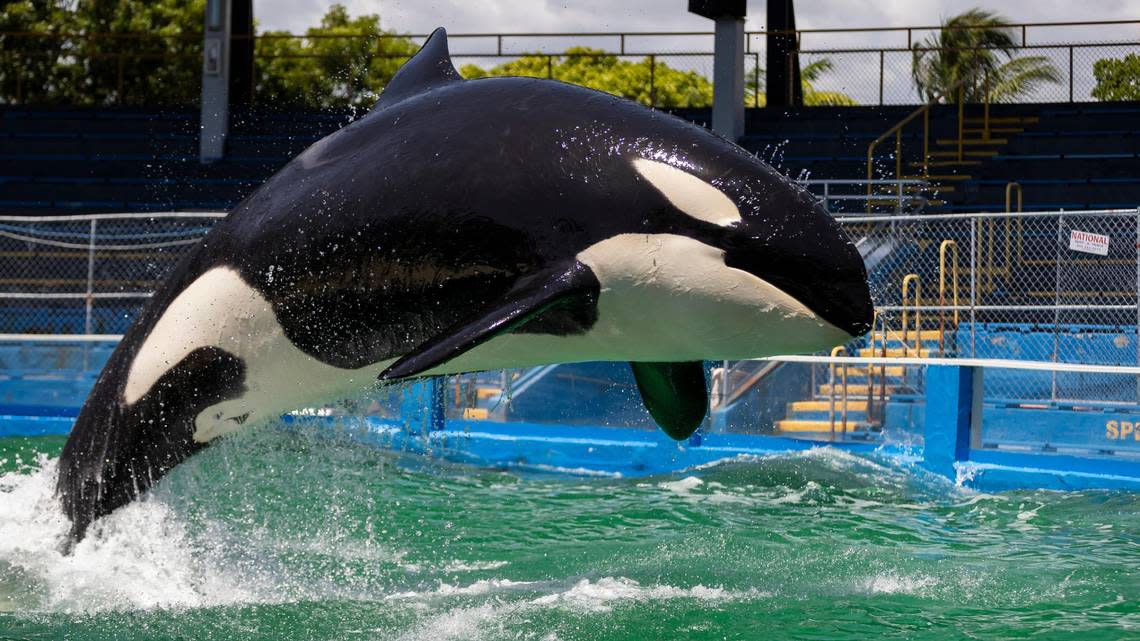
“You want to prepare her as best you can,” said Mike Partica, a trainer who helped return two captive dolphins in Turkey to the wild and now is working for a non-profit overseeing Lolita’s care and daily activities.
Partica’s comments on a recent Saturday afternoon at the nearly empty “Whale Bowl” stadium at the Seaquarium capture the novel arrangement in place at Miami’s most controversial tourist attraction and for its most famous resident.
Partica works for a non-profit largely funded by Keys developer Pritam Singh and Jim Irsay, the billionaire owner of the NFL’s Indianapolis Colts. Both are advocates for moving Lolita out of the Seaquarium. The non-profit, Friends of Toki, negotiated an agreement with the for-profit Seaquarium to help oversee Lolita’s care and training. Administrations of the charity said it has paid for upgrades to the orca’s pool, including a new chiller for the tank.
READ MORE: A pledge to move Lolita the killer whale from Miami Seaquarium, with Jim Irsay’s help
The organization’s title uses the alternative name for Lolita, Tokitae, based on a name given by indigenous people from her native Pacific Coast.
Friends of Toki staff and team members from the Seaquarium say they’re prepping the animal for what the group’s staff describes as a credible chance to live in natural waters again for the first time since she was captured at age 4 in 1970 in Puget Sound.
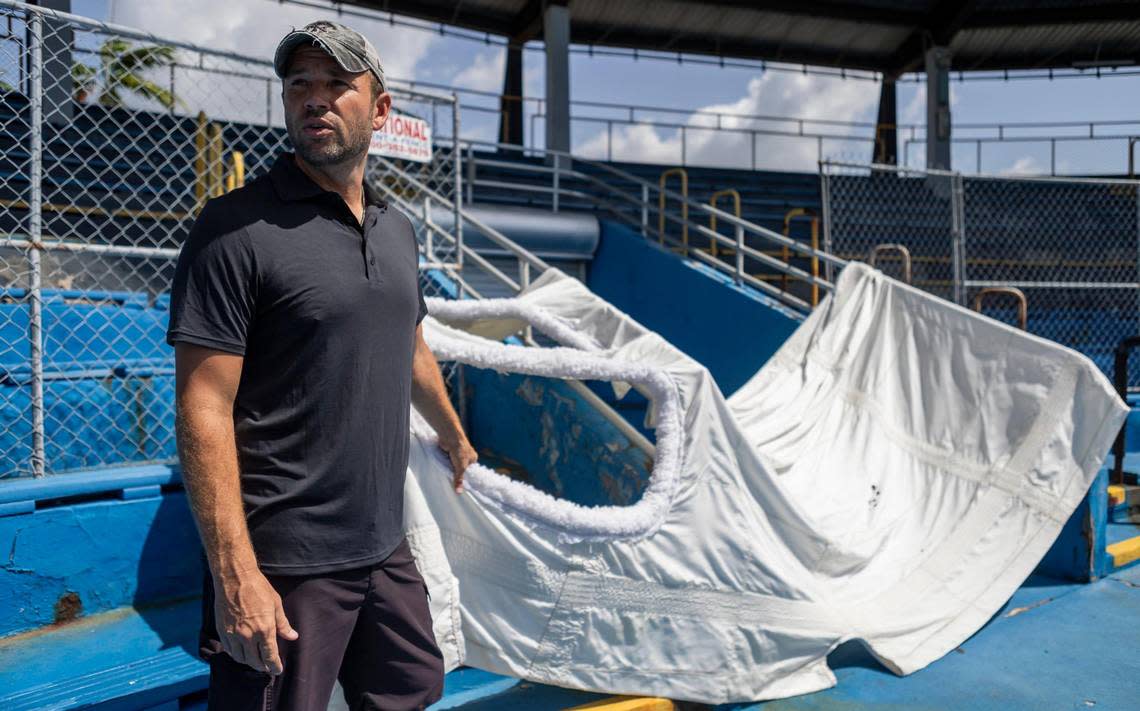
Multiple daunting tasks remain to relocate Lolita. That included Irsay’s pledge to create the private netted habitat that would be the orca’s new home, resolving regulatory concerns about what impact her presence may have on the behavior of native orcas nearby, and answering the central question of whether a captive animal that nearly died of pneumonia last fall will be healthy enough for that kind of move.
As with most components of Lolita’s future, the announced effort to finally move her out of the Seaquarium is both controversial and complicated.
Some advocates for the orca see the plan for a new home in natural water as distracting from an urgent need to find her more humane artificial quarters as her tank deteriorates.
Joe Kleiman, a journalist who covers the attractions industry and documents the Seaquarium’s maintenance issues in his Themed Reality blog, is part of a group urging Irsay and the Seaquarium to build Lolita a new tank immediately.
“There is this plan to move her to a sea pen. That’s fine and good,” he said. “But the condition of the tank is just atrocious. It’s what we consider tantamount to animal abuse.”
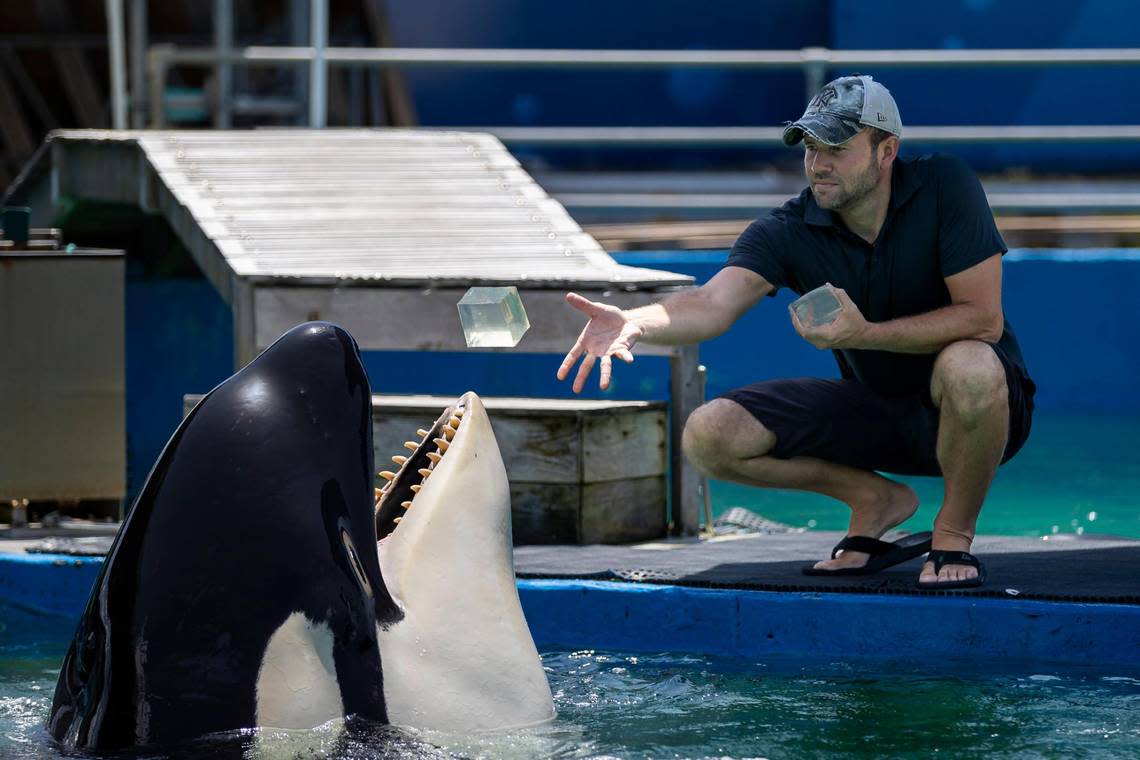
A group of trainers and animal specialists who worked with Lolita in the past launched a group called Truth4Toki as part of a campaign to relocate the orca to more humane accommodations, either at the Seaquarium or in Orlando’s SeaWorld and not risk the trauma of moving the mature marine mammal across the country to natural waters for the sake of a feel-good narrative.
“She is 58 years old and battles chronic illness and is not a candidate for release,” reads the group’s petition on change.org. “Lolita has survived this long because of us. So please listen to us. Her life depends on it.”
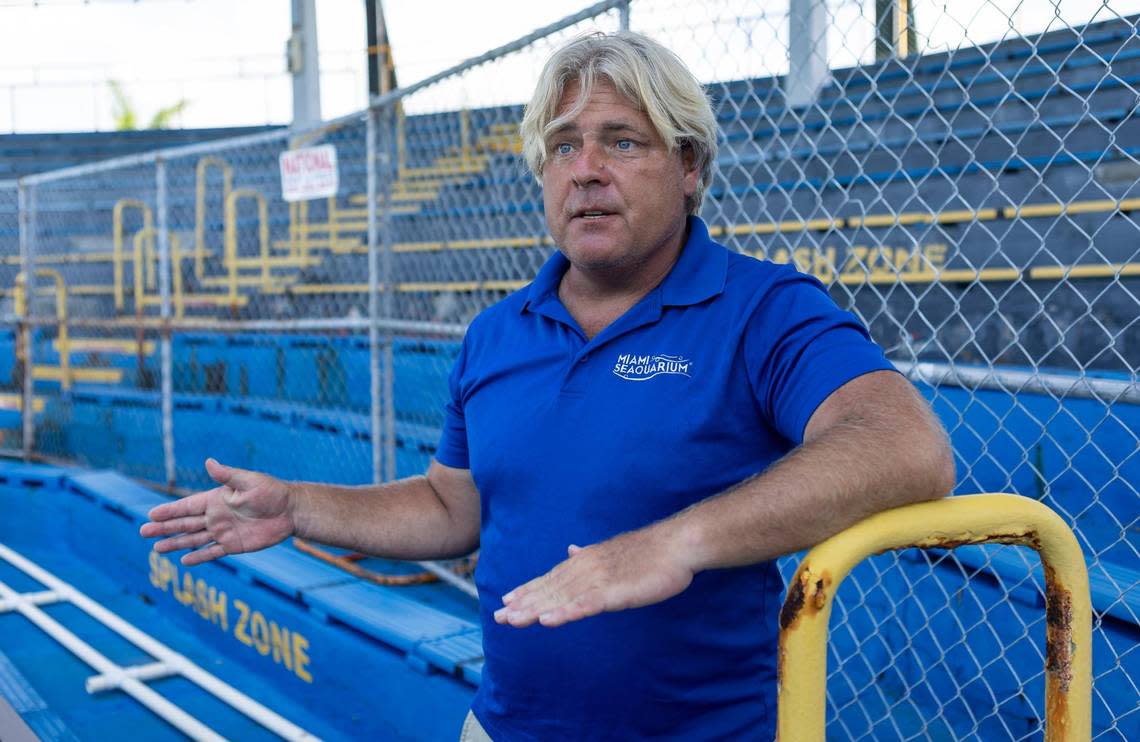
Tom Reidarson, a former SeaWorld veterinarian, says he’s generally not an advocate for freeing captive dolphin and orcas after years of human interaction and handling. But he’s part of the Friends of Toki team preparing Lolita for a path to natural waters. He said the condition of her Seaquarium environs makes the plan the best option.
“This place is falling apart,” Reidarson, now a consultant, said as Lolita swam the perimeter of the tank behind him. “We are not interested in moving all orcas to net pens. It’s just her.”
For years, Lolita’s owners at the Seaquarium rejected calls for freedom, saying that releasing the animal into the wild would doom her while robbing her of professional care and feeding.
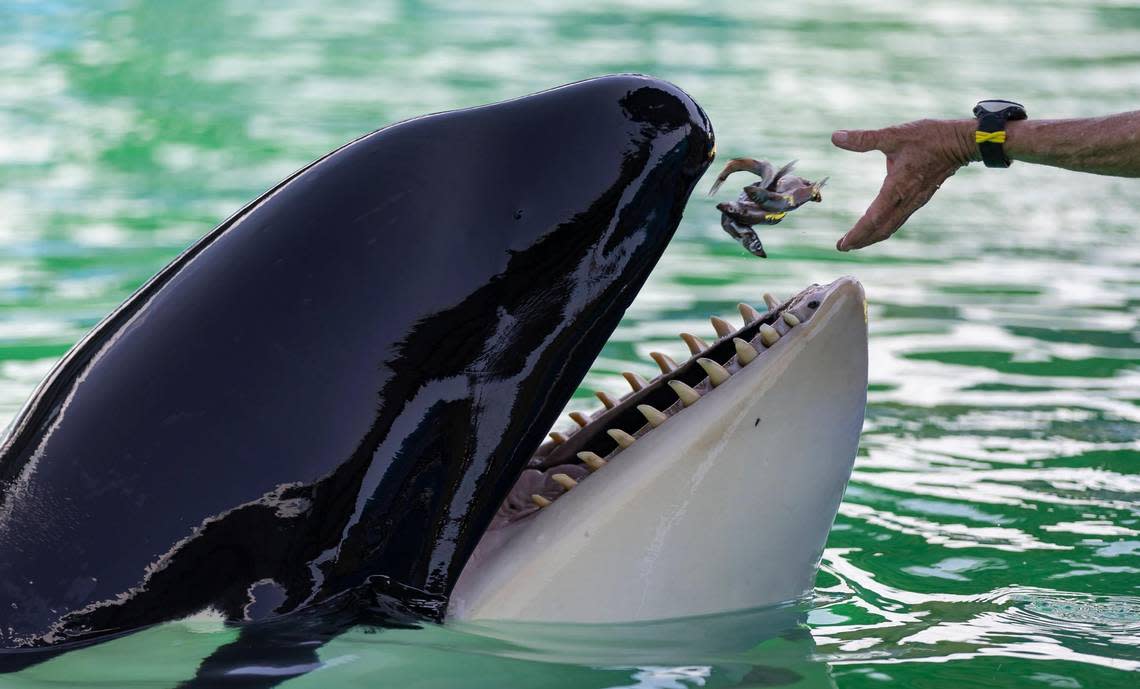
“The activists really don’t genuinely care about Lolita, but we do,” Robert Rose, the attraction’s longtime curator under previous owner Arthur Hertz, told the Herald in 2014, three years before Hertz died. “I’ve been with Lolita longer than my wife. Lolita is our family member, and we are going to take care of her until the very end.”
That was when Lolita was the star attraction, performing in a waterfront tank surrounded by ticket-holding visitors on metal bleachers. The park’s new owner, the Dolphin Company, took over the county-owned property and lease in March 2022.
At the time, the Lolita stadium was in the midst of an unsafe-structures proceeding by county inspectors. They issued a violation notice in 2021 with a recommendation to close the venue to the public and limit occupancy to a small number of animal-care staff. Federal animal inspectors also found problems with the Lolita facility at roughly the same time, making 2021 the final year for Lolita’s shows before park goers.
Shortly after taking over the park, the Dolphin Company announced a permanent end to Lolita’s public performances, though trainers continued to walk her through her daily routine of exchanging tricks for food. The venue remains under the county unsafe-structures order, with pressure building to complete major repairs.
Lorna Meija-Lopez, a spokesperson for the county’s Regulatory and Economic Resources Department, said agency staff are finalizing an agreement with the Seaquarium governing potential upgrades to Lolita’s tank. The tank’s current condition and shaky future is adding to the pressure to relocate Lolita from a theme park that rents the facility from Miami-Dade, which owns the waterfront grounds.
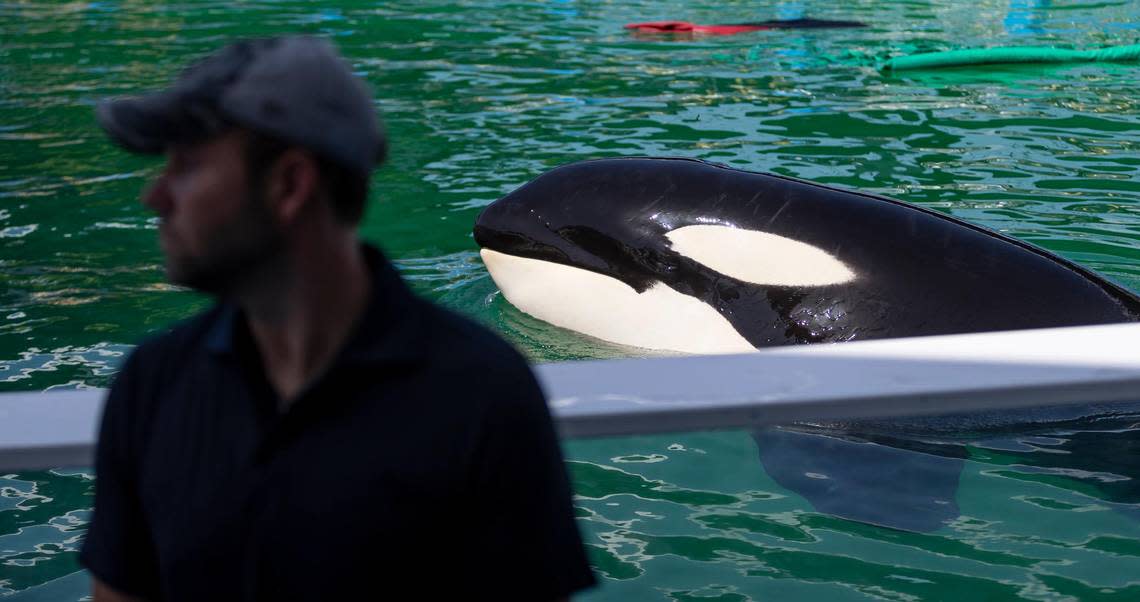
“The structure of the whale tank is one of the factors considered in the decision about potentially relocating Lolita,” Meija-Lopez said in a recent statement. “We have ongoing concerns about how any further repair work would impact Lolita/Tokitae given that the 57-year-old orca has a documented history of reacting sensitively and negatively to external stimuli that could be caused by repairing her tank.”
The announced relocation plan is to use the sling to load Lolita onto a truck and then a cargo plane for a six-hour cross-country trip to Washington state. After another truck ride and transition time in a tank, Lolita would eventually live in a “sea pen” — a natural body of water enclosed by netting to keep Lolita inside. Overall, the trip is expected to last 12 to 16 hours.
To prepare for that new habitat, Partica and other specialists say they’re tweaking Lolita’s Seaquarium environs to make the move less jarring.
A rod with green strips of fabric rests at the edge of the tank, designed to resemble the kelp Lolita may find in a natural habitat on the Washington coast.
Plans for future acclimation exercises include introducing Pacific salmon to a tank that now only has two occupants: Lolita and Li’i, a dolphin serving as her designated companion. Partica said underwater speakers will eventually simulate sounds Lolita could hear in the Pacific, including fellow orca calls and passing powerboats.
Lolita also has been weaned off her old daily habit of flips, splashes and other tricks that trainers wove into multiple shows a day for ticket holders. Even with empty stands, the tricks continued with trainers to keep Lolita active, but Partica said the new regimen has less emphasis on past stunts.
“It was a little bit difficult at first,” he said as Lolita circled the tank underwater behind him, surfacing occasionally with a splash or a sputter from her blowhole. “She’s not always receptive to new things.”
One exercise not on the training schedule is teaching Lolita how to survive in the wild. That’s not an option, Partica said, with the orca considered far too domesticated to be ready for catching fish on her own after a lifetime of being fed by humans.
“She’s been dependent on people since she was 4 years old,” Partica said. “She needs people all the time. That’s never going to change.”
Added Andrew Scullion, a veteran marine-mammal trainer working for the Miami Seaquarium: “There is no plan to send her out in the wild.”
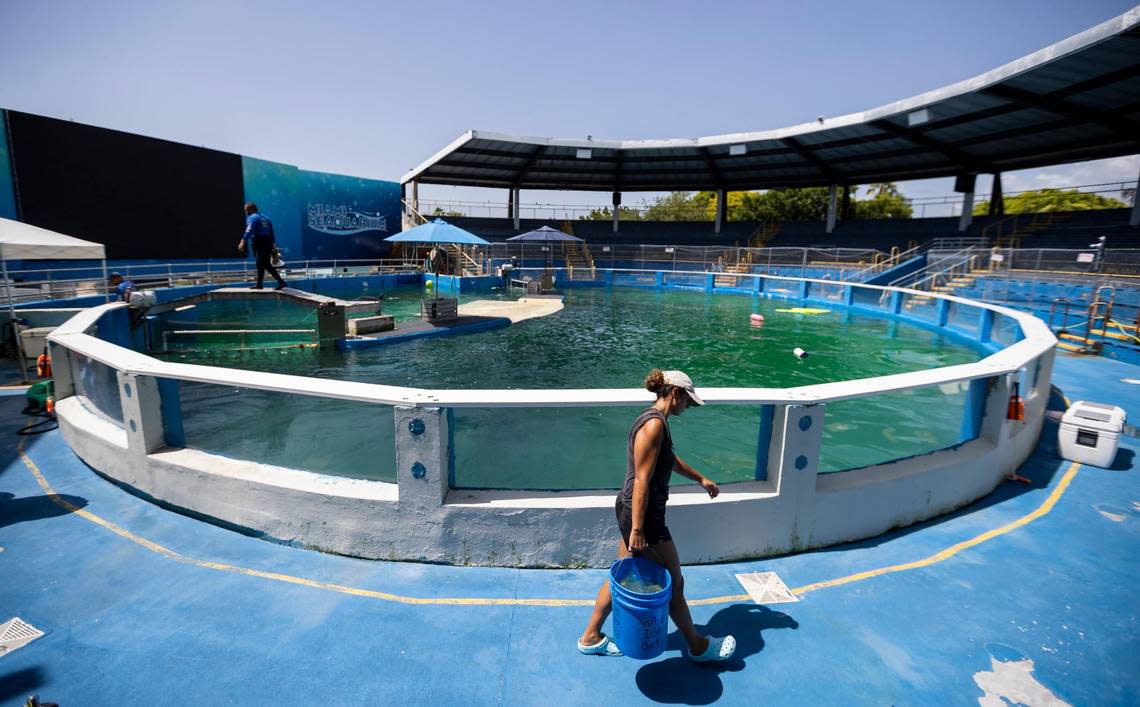
Charles Vinick is the executive director of Friends of Toki. He said one barrier to releasing Lolita into the wild is potential impacts to native Southern Resident orcas like her, who may alter behaviors if introduced to a new mature killer whale in their territory.
“You can’t introduce things to them that you think may be appropriate but could change their behaviors,” he said..
Orcas are part of a federally protected endangered species, adding to the regulatory hurdles Friends of Toki faces in winning approval for an enclosed sanctuary in the Salish Sea region Washington State, which includes the San Juan Islands and Puget Sound.
“Surely the dream for many many people is some advanced freedom,” he said. “But that’s not the plan.”
Instead, he described an area of natural water protected by nets that would be at least 10 times wider and far deeper than the tank that is Lolita’s home. Trainers and veterinarians would tend and feed Lolita from floating platforms and boats, and a 24-hour security along a wider netted perimeter would keep boats away. There’s a chance Lolita would have company in Li’i, the dolphin that also lives in her Seaquarium tank.
“We hope they can remain the companions they are,” Vinick said.
Partica said he plans to accompany Lolita on the trip to the West Coast, which would involve the orca being partially submerged in a fresh water tank on a cargo plane while trainers interact with her. In Washington, she’d likely be transferred to a tank similar to the one where she lives now, followed by a larger one and then a release into a penned off area in the Puget Sound area.
While her swimming options would expand dramatically, Lolita would still have access to scheduled feedings, medical exams and other elements of her current routine. An underwater net would prevent her from joining orcas living free in the ocean.
Howard Garrett, founder of the Orca Network and a longtime advocate for Lolita’s release, said he thinks the orca’s first four years of life swimming with her family pod imparted enough vocabulary and skills to allow a return to open waters after some acclimation work in the sea pen. He also thinks there’s a good chance members of the original pod — including an orca in her 90s known as Ocean Sun and believed to be Lolita’s mother — would allow Lolita to rejoin them.
“She still uses the calls she learned before the capture,” Garrett said. “We can extrapolate she still has a pretty vivid memory of her life before captivity.”
The most famous liberated orca offers encouragement and caution for Lolita’s path out of the Seaquarium.
Keiko was a captive orca in Mexico when he was featured in the 1993 “Free Willy” movie, and pressure soared after the film’s release to free the orca from captivity.
Warner Brothers, the movie’s producer, teamed with non-profits to fund his release to a temporary tank in Oregon before flying to Iceland in 1998 on his way to a new life at sea. Until 2002, Keiko lived in a netted pen in Icelandic waters as trainers conditioned him to a future life in the wild, including learning to catch fish and to break the habit of spending so much time at the water’s surface, according to a summary by the Ocean Futures Society.
Keiko left the pen in 2002 for a life in open waters, while still having access to food provided by human handlers stationed near his preferred swimming grounds. He died the following year of pneumonia.
Multiple hurdles remain before that milestone could be an option for Lolita. Irsay hasn’t announced that Friends of Toki controls or owns the water where a sea pen would be created. Constructing that kind of open-water pen requires approval at multiple levels of government, including in Washington, D.C.
But backers behind the effort say they’re confident the pieces will fall into place for the high-profile orca and a relocation plan that’s got political support in both Miami and Washington state.
“Thanks to Jim Irsay, we have the best consultants able to work as quickly as possible,” said Singh, a hotel developer in the Keys who has given $1 million to Friends of Toki. He said Irsay has given about $5 million, along with pledging to spend what it takes to get Lolita moved. “If the government accepts this is an emergency, there are processes for moving even quicker.”
In a July 5 letter to the president of the Dolphin Company, Miami-Dade Mayor Daniella Levine Cava noted repair work on the tank was halted because the noise, vibrations and smells agitated Lolita. She said the county still requires an independent structural assessment of the condition of the Lolita tank and surrounding area.
“Finally, we urge the Seaquarium to continue taking all the necessary steps to expedite Toki’s relocation,” Levine Cava wrote. “Please know that you can count on the Miami-Dade County team for any support needed in this process.”
Irsay’s office referred questions to the Friends of Toki. While his public statements help drive publicity to the effort, they have also proven overly optimistic. In April, Irsay posted on Twitter he hoped to have Lolita to Washington state by early 2024. In June, he posted that his team of trainers and supporters were “working hard...to get Lolita out to Washington state in late September.” On July 4, Irsay posted: “By Xmas is the hope!”
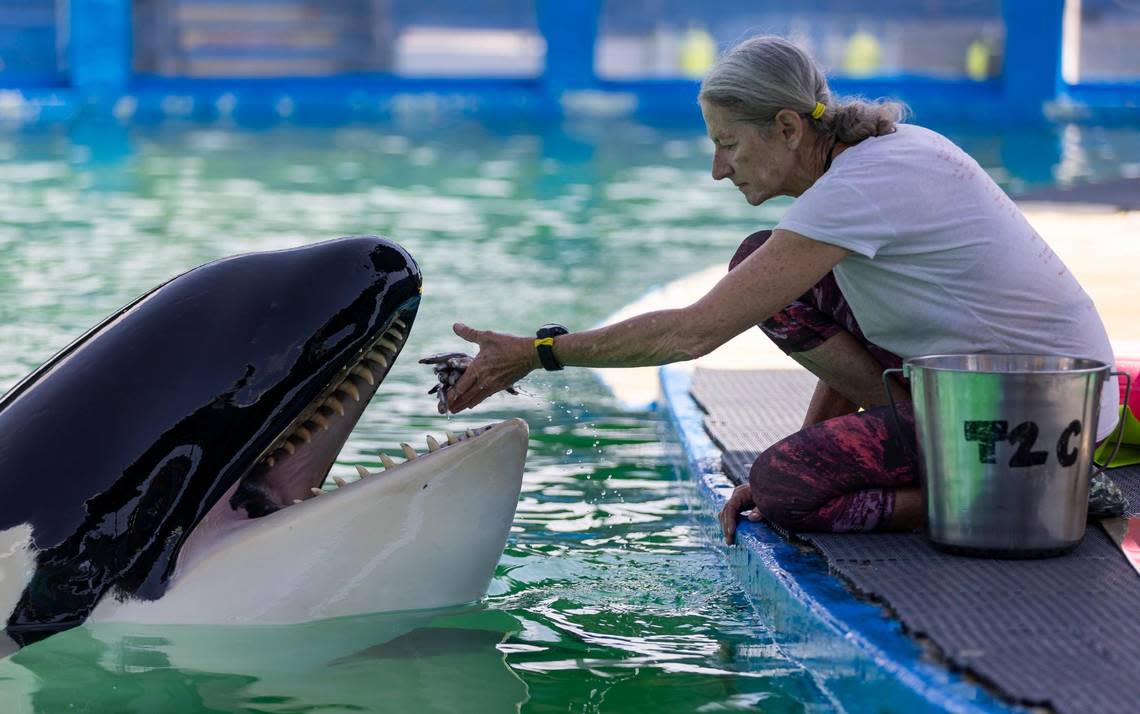
Among the challenges facing Irsay is the ultimate decision on what to do with Lolita. Trainers working for Friends of Toki and the Seaquarium both said there’s a chance future health issues could prevent Lolita from moving to natural waters.
“If we were ready to transport her, if she had an inkling of a health issue, we would postpone,” said Scullion, the Seaquarium trainer. “Toki’s health is priority one.”
Lolita remained on antibiotics this summer after what Reidarson described as a nearly fatal bout with pneumonia last fall. “It became pretty dire,” he said. But with medicine and good luck, he described Lolita as having put the health scare behind her. “She’s actually really healthy right now,” he said.
This article was updated to reflect the correct paraphrasing of Charles Vinick’s comment that one regulatory concern about a release of a captive orca into open waters is a potential impact on the behavior of wild orcas it encounters.
